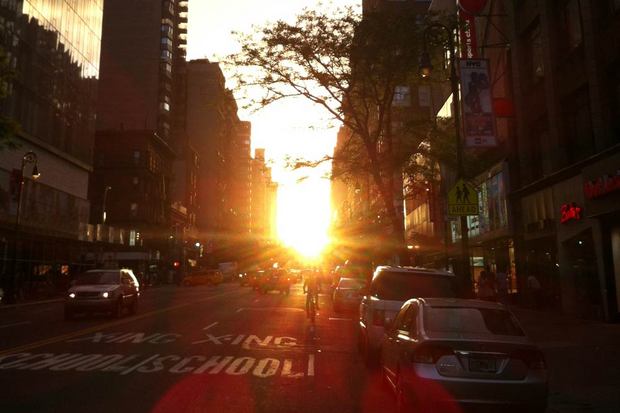New Yorkers Can Catch 'Manhattanhenge' Sunset Today and Tomorrow

Today and tomorrow (July 12 and July 13) are two of the most special skywatching days of the year — if you happen to be in New York City.
Weather permitting, folks in the Big Apple's most famous borough can observe a gorgeous "Manhattanhenge" sunset on both days. And the next opportunity to get such an eyeful won't come until next spring.
"Occurring twice in May and twice in July, the unique phenomenon features a perfectly aligned sunset beaming down the east- and westward roads of the borough’s grid," Accuweather explained. "The result is a dazzling glow that illuminates the north and south sides of the streets' towering buildings."
Manhattanhenge's name, of course, is a nod to the ancient British monument Stonehenge, which was built with the sun's path through the sky in mind. Every year on the northern summer solstice, an observer standing at a special spot within Stonehenge sees the sun rise directly over the landmark's "heel stone."
So keep your eyes peeled, New Yorkers! You too, tourists — but don't gawk so single-mindedly at Manhattanhenge that you get hit by a bus.
Follow Mike Wall on Twitter @michaeldwall and Google+. Follow us @Spacedotcom, Facebook or Google+. Originally published on Space.com.
Get the Space.com Newsletter
Breaking space news, the latest updates on rocket launches, skywatching events and more!
Join our Space Forums to keep talking space on the latest missions, night sky and more! And if you have a news tip, correction or comment, let us know at: community@space.com.

Michael Wall is a Senior Space Writer with Space.com and joined the team in 2010. He primarily covers exoplanets, spaceflight and military space, but has been known to dabble in the space art beat. His book about the search for alien life, "Out There," was published on Nov. 13, 2018. Before becoming a science writer, Michael worked as a herpetologist and wildlife biologist. He has a Ph.D. in evolutionary biology from the University of Sydney, Australia, a bachelor's degree from the University of Arizona, and a graduate certificate in science writing from the University of California, Santa Cruz. To find out what his latest project is, you can follow Michael on Twitter.









